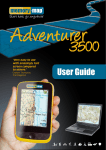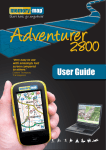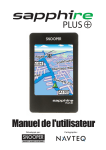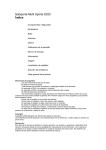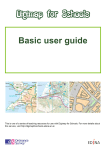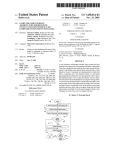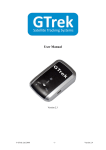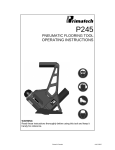Download Adventurer 3000 User Guide - Memory-Map
Transcript
Adventurer 3000 User Guide Introduction Welcome to the Adventurer 3000 User Guide. This manual is designed to walk you through the features of the Adventurer 3000 and how to get the most from your GPS. If you want to start using your GPS straight away please take a few moments to read through the Quick Start guide to familiarise yourself with the GPS and how it operates. This manual will walk you through the advanced features of the GPS, including how to send overlays (routes, marks and tracks) and maps from your PC to the Adventurer 3000. Contents Quick Start Guide .................................................................................................................................................................................................................................................. 2 Main Menu and Buttons ................................................................................................................................................................................................................................... 3 Memory-Map Basic Menu ................................................................................................................................................................................................................................ 4 Memory-Map Extended Menu ...................................................................................................................................................................................................................... 5 Using the Adventurer 3000 .......................................................................................................................................................................................................................... 6 Turning on the GPS and entering map mode ............................................................................................................................................................................... 6 Moving around the map ............................................................................................................................................................................................................................. 6 Opening a map ................................................................................................................................................................................................................................................. 6 Viewing your GPS Position ........................................................................................................................................................................................................................ 6 Viewing additional GPS information .................................................................................................................................................................................................... 6 Routes, Marks and Tracks ............................................................................................................................................................................................................................... 7 Working with Routes, Marks and Tracks .......................................................................................................................................................................................... 7 Creating Routes ............................................................................................................................................................................................................................................... 7 Following a Route ........................................................................................................................................................................................................................................... 7 Creating Marks ................................................................................................................................................................................................................................................. 8 Goto a Mark ........................................................................................................................................................................................................................................................ 8 Viewing Track/trip information ............................................................................................................................................................................................................ 8 Finding a location ................................................................................................................................................................................................................................................. 9 Finding a location by name ....................................................................................................................................................................................................................... 9 Finding a location by grid reference .................................................................................................................................................................................................. 9 Additional Memory-Map Options ................................................................................................................................................................................................................ 9 Additional Device Options ............................................................................................................................................................................................................................ 10 Charging the device and getting the most from the battery ............................................................................................................................................. 10 Using the Adventurer 3000 with Memory-Map on your PC .................................................................................................................................................. 11 Connecting the GPS to Memory-Map on your PC ................................................................................................................................................................... 11 Transferring routes, marks and tracks to the Adventurer 3000 ................................................................................................................................. 11 Transferring routes, marks and tracks from the Adventurer 3000 to your PC ................................................................................................. 12 Sending maps to the Adventurer 3000 ........................................................................................................................................................................................ 12 Sending complete (disc/USB based) maps .................................................................................................................................................................................. 12 Sending Digital Map Shop based maps ........................................................................................................................................................................................... 13 Setting up a new MicroSD card to use in the Adventurer 3000 ......................................................................................................................................... 15 Help and Support .............................................................................................................................................................................................................................................. 16 ADV3000 User Guide v1.3 Page 1 of 16 Quick Start Guide Want to start using your GPS straight away? This quick start guide will quickly familiarise you with the Adventurer 3000 and its features. Charging the Adventurer 3000 Gently open the rubber seal on the right-hand side of the GPS and connect either the supplied mains charger or USB PC cable. A red light will illuminate on the front of the GPS to indicate it is charging and then turn green when the battery is fully charged. Turning on the GPS Press and hold the On/Off button on the left-hand side of the unit. Slide the on-screen Power On slider to the right. The Adventurer 3000 will present you with the main menu, tap the Maps button to put the GPS in map mode. If the touchscreen doesn’t appear to be responding to your input then ensure that Screen Lock switch underneath the On/Off button is in the OFF position (it should be away from the padlock symbol). Viewing your position The GPS will begin locking onto your position straight away. When a lock has been acquired the Padlock icon will illuminate. Tap the icon to jump to your current location and display it on the map. Your position is displayed with the Position icon. As your position changes, the map will automatically scroll with you. If you want to move the map manually drag your finger or stylus across the screen. You can also use the zoom in and zoom out buttons to make the map larger or smaller. To view information such as your current speed and heading tap Extended Menu ( ) followed by Settings & Overlays ( ) and then from the drop-down menu select GPS > Position. The window can be moved and resized and closed using the X in the top right corner. Viewing your track As you move, the Adventurer 3000 will automatically record where you have been by drawing a track behind you. You can view information such as how far you have been by tapping and holding anywhere on this track and then tapping Properties on the menu that appears. You can also view how far you have travelled by a quick press of the button on the front of the GPS. Press this button again to return to the map. Shutting down the GPS When you have finished using the GPS and wish to turn it off, please make sure you close down the Memory-Map software first by tapping Extended Menu ( and selecting Power Off. ) followed by Exit ( ). You can then turn the GPS off by holding down the front button Alternatively, press the On/Off button on the left-hand side of the unit and then select Main Menu and then turn the GPS off by holding down the On/Off button and selecting Power Off. ADV3000 User Guide v1.3 Page 2 of 16 Main Menu and Buttons ADV3000 User Guide v1.3 Page 3 of 16 Memory-Map Basic Menu ADV3000 User Guide v1.3 Page 4 of 16 Memory-Map Extended Menu ADV3000 User Guide v1.3 Page 5 of 16 Using the Adventurer 3000 Turning on the GPS and entering map mode To turn the GPS on press and hold the On/Off button on the left-hand side of the unit. Slide the on-screen Power On slider to the right. The Adventurer 3000 will present you with the main menu. If the on-screen Power On slider is not reacting to your input then check that the Screen Lock switch underneath the On/Off button isn’t in the ON position (it should be away from the padlock symbol). Tap the Maps button to put the GPS into Map mode. This is the principal mode for the Adventurer 3000 and will display the last used map. Moving around the map You can quickly move around the map by tapping and sliding the included stylus (recommended) or your finger across the screen. You can zoom into or out of the map using the Zoom In and Out buttons. Opening a map To open a map tap Extended Menu ( ) to display the full row of icons and then tap Settings & Overlays ( ) to display the drop-down menu. From the list, select Maps to display the Map List. Tap a map name in the list and the map will open. TIP: Another way to open maps based on your current map location is to tap and hold on the currently open map with the stylus. A menu will appear showing available maps where you selected, with a tick against the currently open map. To open another map tap on its name in the list and the map will be displayed. Viewing your GPS Position As soon as you enter Map mode the GPS will begin acquiring a GPS lock. When a lock has been acquired the Padlock icon will turn solid. When the button is solid, tap the button and your location will be displayed on the map with the Position icon. As you move, the position icon will stay in the centre of the screen and the map will scroll underneath automatically. To check the current strength of your GPS signal tap Extended Menu ( ) followed by Settings & Overlays ( ) to display the drop-down menu. From the menu select GPS > Satellites to display current signal information. At least three green bars are required for a GPS lock, with more bars providing a more accurate fix. In normal use the Adventurer 3000 should be able to obtain a GPS lock within a couple of minutes. If the GPS is being used for the first time, or has not been used for some time then it may take a little longer to acquire your position. Viewing additional GPS information The Adventurer 3000 also allows you to view additional GPS information such as your current positional coordinates (in OS grid format or Lat/Long), your speed, heading, average speed, average heading and altitude. To display this information tap Extended Menu ( ) followed by Settings & Overlays ( ) and then from the drop-down menu select GPS > Position. This window can be moved by tapping and holding on the top blue bar and dragging to the required location, or resized by tapping and holding in the bottom right-hand corner and dragging to the required size. You can also customize the data displayed in this window, as well as the units used (mph, kph etc.). Please see Additional Memory-Map Options on page 9 for details. ADV3000 User Guide v1.3 Page 6 of 16 Routes, Marks and Tracks Working with Routes, Marks and Tracks When using the Adventurer 3000 there are three unique forms of navigational data (called Overlays) you can work with – Routes, Marks and Tracks. Routes are a sequence of connected waypoints of where you intend to go, for example a walk or ride that you have created or downloaded and wish to follow. Creating Routes Routes can be created in the Memory-Map software on your PC, or downloaded from popular route sharing websites such TrailZilla (www.trailzilla.com), and then transferred to your Adventurer 3000. Please refer to the help file in the Memory-Map PC software for details on how to create routes in the PC software. Instructions on how to transfer routes from the MemoryMap PC software to your Adventurer 3000 can be found on page 11 of this manual. Although you will find it easier to create routes on your PC and download them to the Adventurer 3000, you can also create routes on the GPS itself. To do this first position the map where you want the route to begin. Tap Extended Menu ( followed by Settings & Overlays ( ) ). Select Overlay > Create > Route from the drop-down menu. Tap on the map where you want the route to begin and then tap the map again where you want the next waypoint to be, and so on. The GPS will automatically connect the waypoints together to form a route and join them with a line. When you have finished adding waypoints double tap the screen when placing the last waypoint and the device will exit route creation mode. If you have reached the edge of the map and wish to add more waypoints, end the route as described above and then scroll the map so that you can still see your last waypoint and the map area you wish to add more waypoints into. Tap and hold on the last waypoint and then from the menu select Add WP After and continue adding waypoints as required. You can access more information about the route, view a hill profile, add more waypoints or delete the route by tapping and holding on any one of the lines between the waypoints to access the Route menu (think of tapping and holding the same as clicking the right mouse button on a PC). Following a Route When you are following a route the GPS will direct you to each waypoint and provide detailed route information, such as distance, bearing and time to next waypoint, estimated time of arrival at the end of the route, distance to the end of the route and more. To begin following a route, locate the route on screen and then tap and hold on one of the lines between the waypoints. From the menu that appears, select Follow Route and the two navigation windows will appear. Provided you have a GPS position, the window on the left will show the direction you need to head to reach the next waypoint, and the box on the right will show the route information. As you progress through the route the GPS will automatically select the next waypoint, ensuring you are always on course and heading in the right direction. To stop following a route, simply close both of the navigation windows. ADV3000 User Guide v1.3 Page 7 of 16 Marks are single waypoints that are not part of a route, for example a mark identifying a meeting point, or the location of a geocache. Creating Marks Like routes, marks can either be created on your PC and downloaded to the Adventurer 3000, or created on the GPS itself. Please refer to the help file in the Memory-Map PC software for details on how to create marks in the software. Instructions on how to download marks from the Memory-Map PC software to your Adventurer 3000 can be found on page 11 of this manual. Creating marks on the GPS itself is easy. Simply move the map to where you would like to drop the mark. Tap Extended Menu ( ) followed by the Mark icon (shown). Now tap on the screen where you would like the mark and you will see a flag added to the map. You can edit the properties of the mark, such as changing its name, or fine tuning its grid reference by tapping and holding on the mark and selecting Properties… from the menu. When in the Mark Properties window you can change the name of the mark by tapping inside the Name box and then tapping the Kbd button to access the keyboard. You can use the same method to fine tune the position of the mark, or add notes for the mark, such as the telephone number of a pub. When you are finished editing the mark, tap OK to save the changes and return to the map. Goto a Mark The Adventurer 3000 can direct you to a mark, giving you the direction to head towards and how far you are from the mark. To use the Goto Mark feature, either locate the mark you would like to head toward, tap and hold on the mark and select Goto Mark, or tap the Mark button and select the mark you would like to head to. Two navigation windows will appear, with the window on the left showing the direction you need to head to reach the mark, and the box on the right showing navigation information. To stop navigating to the mark simply close both of the navigation windows. To delete the mark tap and hold on the mark and select Delete from the menu. Tracks are essentially a breadcrumb trail of where you have been, as recorded by the GPS. As you move, the Adventurer 3000 will automatically record the track, showing where you have been. Tracks are automatically recorded by the GPS when you are moving and are represented by a solid line that will appear behind your GPS position. The track will automatically record details on how far you have gone, how long you have been moving, your maximum speed and your average speed. Tracks can be saved to your PC to review and keep. Please see details on how to do this on page 12. Viewing Track/trip information To view details on your trip, such as distance covered, maximum speed and total time moving, tap and hold on the track and select Properties… from the menu. You can do this as the track is being recorded to see details in real-time, or once you have finished your journey to get an overview of the trip as a whole. You can also view trip distance information by pressing the button on the front of the unit. Total distance travelled will be displayed on the screen, along with brightness controls and options to put the unit into sleep mode or exit Memory-Map and return to the main menu. ADV3000 User Guide v1.3 Page 8 of 16 Finding a location Finding a location by name If you know the name of a location you can jump straight to it by using the Find Place feature. Tap Extended Menu ( followed by Settings & Overlays ( ) ) and then select Find Place from the drop-down menu. The Find Place search works on a filter, so the more letters of the place you search for the less results there will be to look through. For example if you typed “Bir” then the search would return hundreds of places all with “Bir” in the name. If you searched for “Birmingham”, however, then fewer results will be returned allowing you to quickly locate the place you were searching for. To search for a place tap in the Find box and then tap the Kbd button in the bottom corner to bring up the on-screen keyboard. Now, type in your search and then press the - -> button to perform the search. The results will be displayed below. To display the location on the map simply double tap its name in the list. If you want to automatically drop a mark at the location as well make sure the Create Mark box is ticked first. Finding a location by grid reference If you know the grid reference (or Latitude/Longitude) of a location then you can display it using the Find Place feature. Follow the steps above to enter the Find Place menu and tap in the Coordinates box. Bring up the keyboard and type in the grid reference you want to locate, e.g. SU 62392 51191. Press the Enter key on the keyboard and the location will be displayed on the map. If you want to place a mark at the chosen location make sure the Create Mark box is ticked first. Additional Memory-Map Options Tapping the Extended Menu ( additional options and settings. ) followed by Settings & Overlays ( ) brings up the drop-down menu providing access to Map – View all maps installed on the Adventurer 3000 and open the one of your choice. Whenever you send a new map to the Adventurer 3000, access the map list first and tap Refresh to ensure the map list is updated. Overlay – Manage the overlays (routes, marks and tracks) on your device. Options include the overlay manager, which allows you to work with your overlays, creating and deleting overlays and showing and hiding overlays. You can also open overlays sent from your PC, or save overlays ready for transfer to your PC. Please see page 11 for more details. Find Place – Search for a location or grid reference. Please see the section above for more details. Settings – change settings for the device, including units of measure (mph, kph) and position format (British National Grid, Lat/Long etc.). The Settings options also lets you customise the navigation data displayed when following a route or a mark, and when viewing GPS position information. GPS – view satellite signal strength and additional GPS information. You can also drop a mark at your current GPS position from here. License – allows you to check the status of the map licences on your MicroSD card. Help – provides a quick refresher about the information in this manual. Perfect for when you are out and about. Exit – saves all overlay data and then exits map mode, returning you to the main menu. Always use this (or the Exit ( to exit Memory-Map before turning off the device. ADV3000 User Guide v1.3 ) icon) Page 9 of 16 Additional Device Options Additional options for the Adventurer 3000 can be accessed from the Setting button on the main menu screen when you turn on the GPS. These settings include: Brightness – Adjust the brightness of the backlight. The brighter the backlight the easier the unit will be able to be seen in daylight. However, a bright backlight setting will consume more power. Volume – Change the volume level from the internal speaker. You can also turn off the sound made when tapping the screen by setting Touch Tone to off. Language – Change the language of the main menu. The language in Memory-Map itself can be changed separately, if required. Touch Calibration – Recalibrate the touch screen if you are finding screen taps have become inaccurate. The screen will be calibrated for you initially, so you do not need to do this unless required. Power Save – Allows you to control whether the backlight or the device turns off after a period of inactivity. Due to the way Memory-Map records your track log when running we strongly recommend setting the Power Down Time to Always On and the Backlight Off Time to 10 seconds when using Memory-Map on the device. These settings can be used with other applications available for the device, such as the Golf ShotSaver software. Information – Provides information on the hardware and allows you to update the device as updates are available. Charging the device and getting the most from the battery The Adventurer 3000’s battery can be charged using the included mains charger, car charger or USB charger when connected to your PC. For the quickest charge we recommend using the mains charger. The light on the front of the unit will turn red when charging and then turn green when the unit is fully charged. The Adventurer 3000 has two low power state modes. These are Sleep mode and Screen Lock mode. These modes can be accessed by pressing the On/Off button whilst the Memory-Map application is running and then selecting either Sleep GPS Off or Lock Screen. The Sleep GPS Off mode will place the Adventurer 3000 into a hibernation state much like the standby feature on most modern televisions. The unit will no longer receive a GPS position or draw a track when using this mode. The Lock Screen mode will place the Adventurer 3000 into a low power use mode by turning the touch screen, backlight and touch interface off. The unit will continue to receive a GPS position and draw a track when using this mode. To return to normal use after using either of these modes press the On/Off button again. ADV3000 User Guide v1.3 Page 10 of 16 Using the Adventurer 3000 with Memory-Map on your PC Connecting the GPS to Memory-Map on your PC Unlike PDA’s, Garmin or other GPS units the Adventurer 3000 is seen by your PC as a removable drive. This means in MemoryMap you do not interact with the device using the options under the GPS or Mobile Device menu. Overlays and Maps can be sent to the device using the steps in the following sections. Transferring routes, marks and tracks to the Adventurer 3000 Routes, marks or tracks can be transferred from Memory-Map software on your PC to the Adventurer 3000 by following the steps below: 1. Exit the Memory-Map application on the ADV3000 if it is running by tapping Exit ( ) (you may need to tap Extended Menu ( ) first) and then connect your Adventurer 3000 to your PC with the supplied USB cable. Tap the Press to Connect button on the Adventurer 3000 screen and it will connect to the PC as a removable drive. 2. In Memory-Map on your PC, right-click on the route, track or mark you want to send to the Adventurer and left-click the Save As… option. 3. In the Save As window choose the Removable Drive that contains the MicroSD card inside the unit. It can be easily identified as it will contain a number of Memory-Map folders and a Userdata folder as shown below: Double-click on the Userdata folder and give the file a name so that you can recognise it on the device and then click Save. 4. Safely remove the ADV3000 from your PC by right-clicking on the drive in Computer and selecting Eject from the menu. If you are using Windows XP you will need to use the Safely Remove Hardware option in the system tray to remove the device. 5. Unplug the USB cable from the ADV3000 and then launch Memory-Map application. Tap Extended Menu ( ) followed by Settings & Overlays ( ) and then tap Overlay > Open. A list of files will be displayed, select the file you just saved and your route, mark or track should now be displayed on the screen on top of the map. If you cannot see the file that you saved then please ensure that you have saved it in a supported file type; the Adventurer 3000 supports the following overlay file types: GPS eXchange files (.gpx) Memory-Map Overlay files (.mmo) If you have a route, mark or track that uses a different file type then you will need to import it into the Memory-Map software on your PC and then save it as one of the file types listed above. ADV3000 User Guide v1.3 Page 11 of 16 Transferring routes, marks and tracks from the Adventurer 3000 to your PC To save your routes, marks and tracks for viewing in Memory-Map on your PC please follow the steps below: 1. On the ADV3000 tap Extended Menu ( ) followed by Settings & Overlays ( ) and then tap Overlay > Save As… from the menu. Tap the Kbd button to display the keyboard, give the file a name and then tap OK to save. 2. Exit Memory-Map on the ADV3000 by tapping Exit ( ). Connect your Adventurer 3000 to your PC with the supplied USB cable. Tap the Press to Connect button on the Adventurer 3000 screen and it will connect to the PC as a removable drive. 3. In Memory-Map on your PC click Overlay > Import… In the Open window that appears select GPS eXchange files (*.gpx) from the drop down file type box and then navigate to the Adventurer removable drive in My/This Computer. It can be easily identified as it will contain a number of Memory-Map folders and a Userdata folder. 4. Double-click on the Userdata folder and then open the file you named and saved on your Adventurer 3000. The route, mark or track will now be displayed on your PC. Sending maps to the Adventurer 3000 Both existing Memory-Map complete maps and Memory-Map Digital Map Shop maps can be sent to the Adventurer 3000 and stored on the MicroSD card. To open maps on the GPS tap Extended Menu ( ), followed by Settings & Overlays ( ) and then tap Map… A list of maps will appear. If you have recently sent a map from your PC tap the Refresh button to update the map list. To open a map tap once on the name and the map will be displayed. Sending complete (disc/USB based) maps If you have purchased a complete map (such as OS 1:50k Great Britain, OS 1:25k Great Britain, OS 1:10k Streetview, CAA charts, Marine charts or A-Z) then you will need to follow the instructions below to send and activate it on your Adventurer 3000: 1. Exit the Memory-Map application on the ADV3000 if it is running by tapping Exit ( ) (you may need to tap Extended Menu ( ) first) and then connect your Adventurer 3000 to your PC with the supplied USB cable. Tap the Press to Connect button on the Adventurer 3000 screen and it will connect to the PC as a removable drive. 2. On your PC, Navigate to the C:\Maps_v5 folder (this is the default folder where Memory-Map stores map files). 3. If you have numerous Memory-Map products then there will be several folders, select the folder that is relevant to the mapping you want to send to the unit (i.e. the folder named os50 will contain Ordnance Survey 1:50k Landranger mapping – the 2015 complete maps can be found under DMS/GB/OS2015). 4. In the folder you’ve selected there should be a .qct (will have the Memory-Map icon) and a .qc3 file (not all map files have .qc3 file): Copy and Paste these files into the Maps folder on the ADV3000 removable drive (the amount of time it takes to transfer depends on the size of the mapping). ADV3000 User Guide v1.3 Page 12 of 16 5. Safely remove the ADV3000 from your PC by right-clicking on the drive in Computer and selecting Eject from the menu. If you are using Windows XP you will need to use the Safely Remove Hardware option in the system tray to remove the device. 6. Unplug the USB cable from the ADV3000 and then launch Memory-Map application. Tap Extended Menu ( ) followed by Settings & Overlays ( ) and then tap Map… this will load up the Map List window. Tap the Refresh button and the map you transferred should be displayed, tap on the map name. 7. You should then get a message stating the “license for resource xxxxxxxx has not been activated”, tap on the X in the top right-hand corner of this window then close the Memory-Map application by tapping Exit ( tap Extended Menu ( ) (you may need to ) first) 6. Connect your Adventurer 3000 to your PC with the supplied USB cable. Tap the Press to Connect button on the Adventurer 3000 screen and it will connect to the PC as a removable drive. 7. Open the Memory-Map software on your PC and click Help > License Management… > SD Card… A window will appear named Licenses for attached storage card which lists all the mapping/resources you can activate for the Adventurer GPS. 8. Select the relevant mapping/resource from the list so it becomes highlighted and then click the Activate… button. The status of the mapping/resource should change from ‘ None’ to ‘Full, No Expiration’ (if it doesn’t then you may not have any activations/licences left in your account). 9. Safely remove the ADV3000 from your PC by right-clicking on the drive in Computer and selecting Eject from the menu. If you are using Windows XP you will need to use the Safely Remove Hardware option in the system tray to remove the device. 10. Unplug the USB cable from the ADV3000 and then launch the Memory-Map application. Tap Extended Menu ( ) followed by Settings & Overlays ( ) and then tap Map… this will load up the Map List window. Tap on the name of the map you want to view and this time it will display on the screen. Sending Digital Map Shop based maps If you have purchased a Digital Map Shop (DMS) map (such as OS 1:50k DMS, OS 1:25k DMS, OSNI, France IGN 1:25k or Historical) then you will need to follow the instructions below to send and activate it on your Adventurer 3000: 1. Exit the Memory-Map application on the ADV3000 if it is running by tapping Exit ( ) (you may need to tap Extended Menu ( ) first) and then connect your Adventurer 3000 to your PC with the supplied USB cable. Tap the Press to Connect button on the Adventurer 3000 screen and it will connect to the PC as a removable drive. 2. Open the Memory-Map software on your PC and click Map > Map List… In the map list window select the map you want to send to the device then move to the specific area you require. 3. Click the New Route ( ) button on the toolbar and create an route around the area you wish to send. You can zoom out if you wish so you can see more of the map. When you are finishing your route please make sure the last waypoint finishes on top of the first one so that the route is enclosed. 4. Right-click on the route you have created and select the menu option Operations > Enclosed Area > Send to Mobile Device… A window called Send Map to PDA should appear (as pictured). Click the Storage card on PC button and then the ADV3000 User Guide v1.3 button. Page 13 of 16 5. In the Browse for Folder window navigate to the Adventurer removable drive. It can be easily identified as it will contain a number of Memory-Map folders and a Userdata folder. Double-click the Maps folder to select it and then click OK to send the map to the device. 6. A License Management window may appear stating that the mapping/resource requires online activation, click Activate… 7. An Activation window will then appear (as pictured) prompting you to use your mobile device sqkm to activate that particular area of mapping on the device: If you are happy with the amount of sqkm the system is quoting and have sufficient sqkm credit then click the Activate button. If it is more sqkm than you were expecting or you don’t have enough sqkm credit then you can click the Cancel button to abort the activation process. This will then allow you to adjust your enclosed area and follow steps 3-6 again. 8. Safely remove the ADV3000 from your PC by right-clicking on the drive in Computer and selecting Eject from the menu. If you are using Windows XP you will need to use the Safely Remove Hardware option in the system tray to remove the device. 9. Unplug the USB cable from the ADV3000 and then launch the Memory-Map application. Tap Extended Menu ( followed by Settings & Overlays ( ) ) and then tap Map… this will load up the Map List window. 10. Tap the Refresh button to refresh the map list and then select either the OS 1:1m Route Planner or OS 1:250k Road Atlas map. 11. Move the map to the area covered by the Digital Map Shop map you just sent. Tap the Map List ( ) icon and then select the relevant map from the list. Your Digital Map Shop map will now be displayed on the screen. ADV3000 User Guide v1.3 Page 14 of 16 Setting up a new MicroSD card to use in the Adventurer 3000 If you wish you can use a larger MicroSD card than the one originally supplied with your unit. The Adventurer 3000 supports MicroSD cards up to 32GB and the exFAT file system. For some of the larger maps (such as HD) you will require a larger MicroSD card to use it on the device. To setup a new MicroSD card with the Adventurer you will need to do the following: 1. Create a folder on your Desktop called ADV3000 Backup. 2. With the original MicroSD card inserted, connect your Adventurer 3000 to your PC with the supplied USB cable. Tap the Press to Connect button on the Adventurer 3000 screen and it will connect to the PC as a removable drive. 3. Navigate to the Adventurer’s removable drive, it can be easily identified as it will contain a number of Memory-Map folders and a Userdata folder. Select the folders listed below, right-click then select Copy: 2577 ASIMAP Pictures Userdata 4. Open the ADV3000 Backup folder, right-click anywhere in the window and select Paste. Windows will now copy the files and folders on the original Adventurer MicroSD card. 5. When the file transfer has finished safely remove the ADV3000 from your PC by right-clicking on the drive in Computer and selecting Eject from the menu. If you are using Windows XP you will need to use the Safely Remove Hardware option in the system tray to remove the device. 6. Switch off the Adventurer 3000 and then eject the original MicroSD card and store it in a safe location (in case you need to ever use it again). Insert the new MicroSD card into the Adventurer 3000, switch it on and get to the main menu (with the Maps, Apps, Pictures and Setting icons). 7. Connect your Adventurer 3000 to your PC with the supplied USB cable. Tap the Press to Connect button on the Adventurer 3000 screen and it will connect to the PC as a removable drive. 8. Navigate to Computer and you should now see the new MicroSD card listed as Removable Disk, right-click on this drive and select the Format… option. A Format window should now appear (as shown): In the 'File System' dropdown, choose exFAT In the 'Allocation unit size' dropdown, choose Default allocation size In ‘Volume label’ type ADV3000 Under ‘Format options’ ensure that Quick Format is ticked. 9. Click Start and Windows format the card to use the exFAT file system (this is important if you plan to use files over 4GB on the card). 10. Navigate to the ADV3000 Backup folder you created and select all the folders within it, right-click and select Copy. 11. Navigate to the new removable drive you just formatted and named ADV3000, right-click anywhere in the window and select Paste. Windows will now copy the files and folders from the ADV3000 Backup folder to the new MicroSD card. 12. When the file transfer has finished safely remove the ADV3000 from your PC by right-clicking on the drive in Computer and selecting Eject from the menu. If you are using Windows XP you will need to use the Safely Remove Hardware option in the system tray to remove the device. ADV3000 User Guide v1.3 Page 15 of 16 13. Unplug the USB cable from the ADV3000 and then launch Memory-Map application. Tap Extended Menu ( ) followed by Settings & Overlays ( ) and then tap Map… this will load up the Map List window. Tap the Refresh button and the map you transferred should be displayed, tap on the map name. 14. You should then get a message stating the “license for resource GPS Features has not been activated”, tap on the X in the top right-hand corner of this window then close the Memory-Map application by tapping Exit ( to tap Extended Menu ( ) (you may need ) first). 15. Connect your Adventurer 3000 to your PC with the supplied USB cable. Tap the Press to Connect button on the Adventurer 3000 screen and it will connect to the PC as a removable drive. 16. Open the Memory-Map software on your PC and click Help > License Management… > SD Card… A window will appear named Licenses for attached storage card which lists all the mapping/resources you can activate for the Adventurer GPS. 17. Select the resource named GPS Features from the list so it becomes highlighted and then click the Activate… button. If you are asked to log in enter your user name and password. You may be asked to give the SD card a name so that you can recognise it later, so fill in a unique name for the card if prompted. 18. The status of the resource should change from ‘None’ to ‘Full, No Expiration’. Your new MicroSD card is now setup to be used with the Adventurer 3000, please refer to the Sending maps to the Adventurer 3000 section above for instructions of how to send and activate your mapping on it. Larger ready to use MicroSD cards for the Adventurer 3000 can be purchased from www.memory-map.co.uk/shop Help and Support For further help, guides and articles about the Adventurer 3000 please visit www.memory-map.co.uk/support ADV3000 User Guide v1.3 Page 16 of 16
















